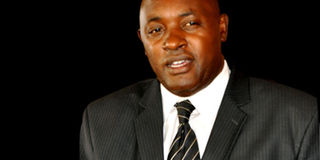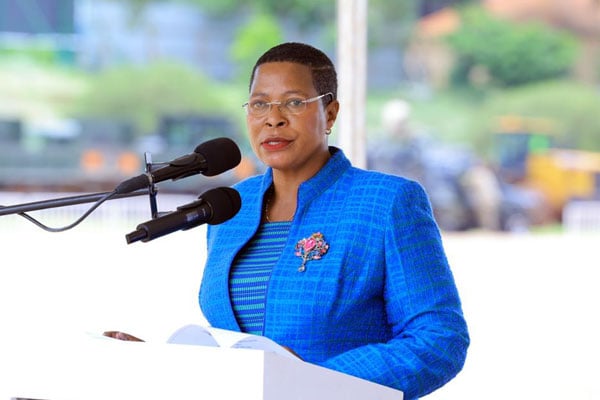‘Nebanda did not take a corrosive substance’

Dr Baryomunsi speaks to Sunday Monitor in Kampala last week. PHOTO BY GEOFFREY SSERUYANGE
What you need to know:
Gagged, arrested. The controversial death of the Butaleja Woman MP Cerinah Nebanda has caused national debate and resulted into the arrest of legislators Chris Baryomunsi and Mohammed Nsereko for allegedly making statements that the government claimed were an incitement to violence. Risdel Kasasira talked Dr Baryomunsi before he was arrested.
1. As a Member of Parliament and a person who has been closely following events after Nebanda’s death, is there something we don’t know?
Well, as Parliament, we got involved; just to be part of the process, with police in the leadership, in order to get the truth. The person who died was a Member of Parliament and she died under unclear circumstances. Our interest was to seek the truth. The law does not disallow that. What is surprising is that the police and the government are extremely opposed to the idea of getting an independent analysis. I don’t know why.
2. Could it be a failure in managing coordinated communication and information outflow from the government that is creating suspicion or there is something government is trying to hide?
We all met at Mukwaya General Hospital where the lifeless body of Nebanda was lying. We discussed how to move forward with the body because as a parliamentary commissioner, I have a responsibility of protecting the welfare of MPs, both when they are alive or dead. A section of Members of Parliament and other officials; namely, the director CIID, Ms Grace Akullo, her deputy Mr Musana and the police surgeon, Dr Byaruhanga, and members of the family were around.
We requested whether we would work with the police because it’s mandated to do investigations. Police agreed that we work in partnership.
We agreed that Parliament nominates a pathologist and that the family also nominates another to join the team of government pathologists to carry out the postmortem. That was agreed at the hospital where the body was lying. We agreed that the body be transported to the anatomy department at the Medical School. We also agreed that the body should only be accessed on the following day to do a postmortem examination in the presence of the three parties - namely; police, Parliament and the family.
We held a meeting and agreed on who enters the postmortem room. It was agreed that the police surgeon, the government surgeon, a surgeon nominated by Parliament, Dr Sylvester Onzivua, the family-nominated Prof. Waminga and the three of us, the doctors nominated by Parliament, a representative of the family, a cousin brother of the late Nebanda, Hon. Emmanuel Dombo, as a Member of Parliament from Butaleja District, to join the team.
But we were requested by the police surgeon that “if you enter the postmortem room, you must sign a form to show that you are part of the process” and all of us agreed to sign the form. That’s how the postmortem exercise was done. But after analysing the body parts, the pathologists were of the view that the cause of death couldn’t be established at that point because the natural causes of death were ruled out.
3. What did you see that made you conclude that it was not a natural cause?
At that point, there are things you can see with a naked eye and you conclude, especially cases of sudden death like this one. Things like a clot in a blood vessel, a ruptured blood vessel or cardiovascular accidents or cases where high blood pressure causes brain damage. In the postmortem room, you remove every organ, examine them and cut them to make sure that they are normal. Once those were ruled out, the pathologists took a decision that the body tissues and samples should be taken from the body and be subjected to further analysis. This analysis is always done at two levels.
We have histological analysis which basically looks at the structure of the tissues to see whether they are in normal structure and also to undertake the toxicological analysis to see whether there is any possible presence of poisons and toxic materials in the body because we had found significant findings in the pancreas, the lungs and in the stomach. That made it necessary that we do further tests. At that point, a decision was also taken that Dr Onzivua, the pathologist nominated by Parliament, takes samples to South Africa and that another set of samples be taken to the government analytical laboratory. After that specimen bottles were brought in the postmortem room and two sets were assembled and the lead pathologist, Prof. Waminga and Dr Onzivua went with the samples for independent analysis. Another official from Mulago went with two MPs; Hon. Bitekyerezo and Hon. Lyomoki, to the government lab in Wandegeya to deposit another set of the samples.
4. In your presentation to Parliament, you said that when you reached Mukwaya General Clinic you found a clinical officer and a nurse who knew how the late Hon. Nebanda was brought and by who. What exactly did they tell you?
I was among the first MPs to arrive at Mukwaya General Hospital. When I reached there, I asked who had information about the cause of death. I was told there were a clinical officer and a nurse who had come from a clinic in the area where the so-called boyfriend was living. I talked to the clinical officer and I asked him whether Hon. Nebanda came to the hospital alive. He told me that she came gasping and for him he thought she was still alive by the time she reached the hospital.
But the hospital director had told me that when he saw her, she was already dead. At that point, Gen. Kale Kayihura [the IGP] entered the room with a phone, saying the President wanted to speak to someone who had information and I asked the clinical officer to speak to him and they moved out. I talked with the nurse who had also come from that clinic. The nurse told me that in the evening of that day, they were approached by two gentlemen. One of Somali origin and another dark-skinned.
They asked these two health workers to go and assist them in their house; that there was a medical emergency. These two health workers insisted that the person be brought to the clinic. But the gentlemen insisted the person was in a very critical condition and was also a high-ranking government official and therefore suggested that they preferred a health worker goes to the house. The health workers prepared emergency drugs as well as intravenous fluids and went with them to the home of these two gentlemen.
5. Did they tell you what happened at the home of these two gentlemen?
They said that while there, another dark-skinned gentleman went back to the clinic and told the health workers that they wanted more fluids which the nurse gave them. But this gentleman told the health workers that he was proceeding to town and was not going back to the house. The fluids were given to his colleague. The nurse told me at some point that the clinical officer gave advice that they should immediately rush to a bigger hospital because he could no longer manage the case as it was getting worse.
That they got into a vehicle of Hon. Nebanda and that the Somali-looking gentleman drove it to Mukwaya General Hospital. When the two gentlemen had come to the clinic, they were driving a blue RAV4 vehicle. But when they went to Mukwaya General Clinic, the two gentlemen handed over the body to the health workers, two phones belonging to Hon. Nebanda and also left the key of the vehicle.
In that confusion, the two gentlemen entered the RAV4 which came following them and drove off. I understand the police found the RAV4 because it had been driven back and parked there. Those are the circumstances I was told by these two health workers how the late honourable was brought to the clinic. But I was also told Police recovered three bottles of Nemoceline, an intravenous fluid.
6. Have you heard anything about where she spent the afternoon of the day she died?
I was told she was with her mother at 2pm in Munyonyo. That she made a phone call to her at 4pm and is said to have been okay, with no problem. But at around 7pm, she was declared dead. Like I said, the police say they recovered three bottles of Nomoceline. These are intravenous fluids used to hydrate patients. To infuse three bottles of nomoceline must have taken more than an hour in my view. That means the clinical officer took some time to manage her at that home.
Secondly, it shows that whatever killed her was administered after 4pm and by one hour to 7pm; she must have been in critical condition. This must have been a substance which is rapidly absorbed in the body and its effects, are systemic, and do not have a corroding effect on the gut and the stomach because we didn’t find evidence of corrosion. It didn’t damage the oesophagus and the stomach. If the toxicology is done, it shows what kind of substance.
7. Is there a possibility that she could have inhaled and not swallowed the substance that killed her and do you think the government could have killed Nebanda?
That’s a possibility because some poisons can enter your body through inhalation. They can be eaten, drunk or swallowed or through injection. All those are possible ways through which poison can enter someone’s body. This we suspect should have swallowed it. Up to now I don’t think the NRM government can kill people like that. But the manner in which it has behaved towards these investigations, it requires them to do a lot of explanation.




